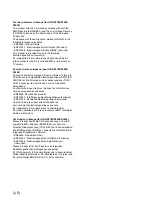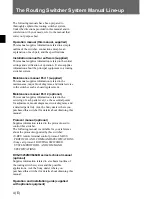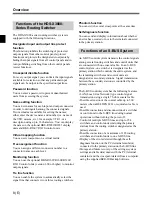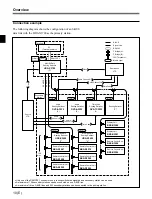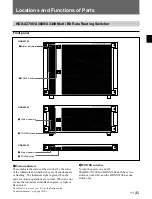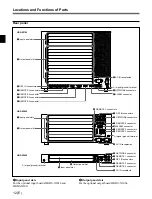
13 (E)
3
REF IN (reference input) connectors (BNC type)
The HDS-X3700 and HDS-X3600 each have two pairs
(A and B), and the HDS-X3400 has one pair only.
The connectors accept analog reference video signals
(black burst signals compatible with CCIR624
standards or tri-level sync signals for HDTV).
Two connectors of each pair have internal loop-
through connections. If loop-through output signals
are not used, put a 75-ohm terminator on any
connector that is not used.
Note
If you wish to synchronize signal switching with the
reference signal, set the timing of signal switching
(odd or even field) and select reference signal A or B
on the PC (terminal emulator).
For further details, refer to the maintenance manual part 1
and installation manual for software.
4
REMOTE 1 connectors (BNC type)
The HDS-X3700 has three connectors (A, B and C),
and the HDS-X3600 has two connectors (A and B),
and the HDS-X3400 has one connector only.
Connect the remote control unit and routing switchers
using a single coaxial cable to control the system via
S-BUS protocol. When you use this switcher as the
primary station
1)
(set the internal P/S switch to P), a
maximum of 253 remote control units and routing
switchers can be connected to these three connectors.
When you use this switcher as a secondary station
1)
(set
the internal P/S switch to S), connect an S-BUS
link to one of the connectors using the supplied
T-bridge (type B).
See “System Connection Example” on page 9(E).
Put the supplied 75-ohm terminator(s) on the unused
connector(s) of the HDS-X3700/X3600 regardless
whether it is the primary station or secondary station.
5
REMOTE 2 connectors (D-sub 9-pin)
The HDS-X3700 and HDS-X3600 has two connectors
(A and B), and the HDS-X3400 has one connector
only.
Connect an external control unit using a Sony 9-pin
remote control cable for use via the RS-422A
interface.
When S-BUS convert mode is selected at the control
terminal, S-BUS control through the REMOTE 2
connector is enabled.
For details, refer to the installation manual for software.
1)Remote control operations via S-BUS protocol consist of
a data link constructed using a single coaxial cable link.
Several pieces of equipment (i.e. routing switchers,
control units, etc.) are connected to this data link for data
transmission in time-sharing mode. One of the connected
6
REMOTE 3 connectors (D-sub 9-pin)
When the switcher is used as the primary station
(internal P/S switch set to “P”), connect the control
terminal to perform the settings required for system
operations.
Notes
• When using the REMOTE 3 connector, set the S4-3
switch on the CPU-317 board to the TERM position
and the S4-2 switch to the P position.
For further details, refer to the maintenance manual part 1
and installation manual for software.
• Use the D-sub 9-pin connectors with inch screws for
connections.
7
REMOTE 4 connectors (BNC) (HDS-X3700/
X3600 only)
These accept a control signal that controls monitoring
of output signals.
The optional BKS-R1607/R1608/R3209/R3210
control units (version 3.00 or higher) can be connected.
Note
The circuitry for monitor selection is located on the
HKDS-X3060, which is designed as an input monitor
circuit. An output monitoring operation is achieved by
“selecting the input selected at the output (regular
output) to be monitored” using this circuit.
8
AC IN (AC power input) receptacles
The HDS-X3700 and HDS-X3600 each have two
receptacles (A and B), and the HDS-X3400 has one
receptacle only.
Connect each to an AC outlet using an optional AC
power cord.
9
NETWORK connectors (modular jacks)
The HDS-X3700 and HDS-X3600 each have two jacks
(A and B), and the HDS-X3400 has one jack only.
For future use.
q;
ALARM connectors (Mini D-sub 15-pin) (HDS-
X3700/X3600 only)
To output the status of the switchers in the same
condition as the status indicators on the front panel.
For details, see “Specifications” on page 17(E) and refer to
the maintenance manual part 1.
switchers is used as the primary station that manages the
use of the data link, while the other equipment is used as
secondary stations which follow directions from the
primary station. The response speed may slow down due
to the number of secondary stations.
.............................................................................................................................................................................................................................




